lordroel
Administrator
Posts: 68,045 
Likes: 49,445
|
Post by lordroel on Aug 30, 2020 6:11:22 GMT
Day 399 of the Great War, August 30th 1915
Naval operations: Eastern Mediterranean
With the growing activity of German submarines in the eastern Mediterranean, the Entente navies have sought to shut down their access to the Austro-Hungarian naval bases they are using in the Adriatic. Today the British Admiralty issues orders for a first batch of trawlers to depart home waters for the Mediterrean, where they are to be used to establish an anti-submarine barrage across the narrow exit of the Adriatic at the Straits of Otranto. To do so, the trawlers will drag large anti-submarine nets in their wake across the straits, hoping to entangle German submarines as they transit to and from the Adriatic, and thereby forcing them from the eastern Mediterranean for a lack of suitable naval bases.
Naval operations: Baltic Sea
Near the Straight of Hari Kurk, Egewold von Berckheim, in U-26, sinks the Russian freighter SS ZEMLYA. This is von Bercheim's last sinking, and his final score is 5 ships and 15,075 tons. U-26 was not heard from again. Nothing was left but speculation for 99 years, until the wreck of U-26 was discovered in May 2014.
Naval operations: German East Africa
At 1248 HMS SEVERN sends a landing party to Simaya Island, looking for signs of German activity. The island is deserted.
|
|
lordroel
Administrator
Posts: 68,045 
Likes: 49,445
|
Post by lordroel on Aug 31, 2020 6:07:49 GMT
Day 400 of the Great War, August 31st 1915
Easter Front: Russian 8th Army to pull back behind the Styr River
Having held up the Austro-Hungarian advance southwest of Lutsk, General Brusilov, given that the enemy is clearly attempting to envelop his positions from the north, orders his 8th Army to pull back behind the Styr River running south of the city. The withdrawal is accomplished without significant interruption, though Lutsk itself is captured by the Austro-Hungarian IX Corps by this evening. While the Austro-Hungarian armies are advancing, it is not the crushing envelopment Conrad had envisioned. Hoping to yet win a decisive victory, Conrad today reestablishes 4th Army at the northern end of the line, taking over IX, X, and XIV Corps from 1st Army, and assigns it the primary mission of advancing beyond Lutsk to Rovno.
|
|
lordroel
Administrator
Posts: 68,045 
Likes: 49,445
|
Post by lordroel on Sept 1, 2020 6:14:18 GMT
Day 401 of the Great War, September 1st 1915
Western Front: Kitchener issues orders today for the Indian Corps in France
Kitchener issues orders today for the Indian Corps in France to remain part of the British Expeditionary Force through the next winter. Though concerns have been expressed in some quarters regarding the ability of the Indian soldier to cope with the cold and miserable conditions of a Flemish winter, Kitchener understands that the Indian Corps have shown themselves capable of operating under such conditions just as well as the British divisions they fight alongside. There were also worries about the losses suffered by the Indian Corps since its arrival in France in October 1914 could be adequately replaced, but since the summer a steady stream of recruits had replenished the Meerut and Lahore Divisions. Of the three thousand replacements who arrived in July, General James Willcocks, the commander of the Indian Corps, wrote that they were 'very good . . . some of them quite exceptionally so, and I feel years younger now as I see these fine fellows joining the ranks.'
Germany: German ambassador to the United States delivers a note containing what becomes known as the Arabic Pledge to Secretary of State Robert Lansing
Upon the instructions of Chancellor Bethmann-Hollweg, the German ambassador to the United States delivers a note containing what becomes known as the Arabic Pledge to Secretary of State Robert Lansing. Based on the decision of the conference at Pless on August 26th in response to the sinking of Arabic, the Germans pledge that no passenger ship of any nationality will be attacked without warning, and that adequate provisions will be made for the survival of passengers and crew.
France: Joffre remains under pressure from government ministers to dispatch several divisions from the Western Front to the Near East
Joffre remains under pressure from government ministers to dispatch several divisions from the Western Front to the Near East, and seizes on a staff study suggesting that the operations proposed by General Sarrail would require eight divisions. He writes today that such a substantial reduction in French strength on the Western Front would have 'disastrous consequences.' Moreover, he questions the entire premise of undertaking operations to relieve the British position on Gallipoli:
It is the British who have led us to the Dardanelles. In reality halting the offensive will be a British defeat. Tomorrow, if we send reinforcements and assume command, we will find ourselves, in case of failure, facing a French disaster.
Eastern Front: Austro-Hungarian 2nd and 7th Armies, as well as Südarmee, have launched assault after assault on the Russian lines along the Strypa River
For several days the Austro-Hungarian 2nd and 7th Armies, as well as Südarmee, have launched assault after assault on the Russian lines along the Strypa River. Though in places they have managed to win some ground, it has come at great cost - the Austro-Hungarian Corps, for instance, has lost over five thousand men in just two days of fighting. Today the Russian 11th and 9th Armies pull back from their lines along the Strypa River, though this is not due to any defeat they have suffered but rather due to the threat of envelopment from the north due to the advance of the north wing of the Austro-Hungarian 4th Army through Lutsk. Brussilov's 8th Army, meanwhile, takes up its new defensive line today along the Putilowka, covering Rovno, and south to the hills west of Dubno.
Naval operations: North of Scotland, east of the Shetland Islands
Konrad Gansser, commanding U-33, begins his third war patrol with the sinking of British freighter SS WHITEFIELD, 2,422 tons, bound from Archangelsk to Clyde and then NICE with a load of wheat. His score is now 8 ships and 12,607 tons.
Naval operations: North Sea
Three ships, His Majesty's Trawlers MALTA, 138 tons, and NADINE, 150 tons; and SS SAVONA, 1,180 tons, carrying a cargo of esparto grass and lead from Oran to Leith; all are lost to a minefield laid in the Thames Estuary by UC-7, commanded by Franz Wäger. Wäger's score is now 3 ships and 1,588 tons.
|
|
lordroel
Administrator
Posts: 68,045 
Likes: 49,445
|
Post by lordroel on Sept 2, 2020 5:44:06 GMT
Day 402 of the Great War, September 2nd 1915
Eastern Front: Falkenhayn informs the commanders on the Eastern Front that operations will need to be wound down as forces will be needed for operations in other theatres
- Falkenhayn informs the commanders on the Eastern Front that operations will need to be wound down as forces will be needed for operations in other theatres. Not surprisingly, Conrad pays no heed to his German counterpart, pushing his armies ever onwards in the vain search for a decisive, and Austro-Hungarian, victory. Neither is Ludendorff inclined to accede to the wishes of the German chief of staff. Throughout the campaign, he has chaffed on the limits Falkenhayn has placed on the armies of OberOst, denying him the opportunity to execute the massive envelopment of the Russian armies he desires. Now Ludendorff decides to 'misinterpret' Falkenhayn's instructions, and plans for an offensive anyway. His objective is the city of Vilna, defended by the Russian 10th Army. Confusingly enough, it is the German 10th Army that will undertake the attack, and divisions are being redeployed from 8th and 12th Armies to the south, as well as the forces that had captured the fortress of Novogeorgievsk. The poor state of the railway running through Kovno, coupled with poor weather making roads almost impassable, however, slows the concentration of German forces opposite Vilna.
- The Austro-Hungarian 4th and 1st Armies, pursuing what is believed to be a defeated foe abandoning the field, instead run up against the new defensive line of the Russian 8th Army, and find themselves unable to further advance. To the south, elements of the Austro-Hungarian 2nd and 7th Armies and Südarmee reach the Sereth River, where the Russian 11th and 9th Armies have entrenched.
Naval operations: North Atlantic
Off the northwest coast of Scotland Walther Schwieger, commanding U-20, opens his fifth war patrol with the sinking of British freighter SS ROUMANIE, 2,599 tons, bound from Archangelsk to Clyde with a load of wood. Schwieger's score is now 16 ships and 74,456 tons.
Northwest of Ireland Heino von Heimburg, in UB-14, damages passenger liner SS SOUTHLAND, 11,899 tons, heading from Alexandria to Mudros.
Southwest of Ireland Walter Forstmann, in U-39, starts his fourth war patrol with a deck-gun attack on British sailing ship SV WILLIAM T. LEWIS, 2,166 tons, carrying a load of timber from Everett to Sheerness. The full-rigged ship is only damaged.
Naval operations: German East Africa
While patrolling the coastline, HMS SEVERN records that the beach at Kilwa Kivinje appears to be entrenched.
|
|
lordroel
Administrator
Posts: 68,045 
Likes: 49,445
|
Post by lordroel on Sept 3, 2020 5:33:09 GMT
Day 403 of the Great War, September 3rd 1915YouTube (The Western Front Awakens - The Tsar Takes Over)Ottoman Empire: the Ottoman government agrees today to cede to Bulgaria northern Thrace and the Maritsa valley should the Bulgarians enter the warUnder pressure from Germany and Austria-Hungary, the Ottoman government agrees today to cede to Bulgaria northern Thrace and the Maritsa valley should the Bulgarians enter the war. The Bulgarian desire to acquire part of Ottoman Thrace was their only territorial claim against the Central Powers, and with the concession the Bulgarians will now achieve all of their expansionist aims by joining the Central Powers and attacking Serbia. Aerial operations: German army airship SL11 get destroyedOvernight the German army airship SL11 undertook a bombing raid of London, and though it did not reach the centre of the city, it dropped a series of bombs on Edmonton, Ponders End, and Enfield after midnight. As it turned for home it was illuminated by a searchlight over the village of Cuffley in Hertfordshire shortly after 2am, which drew the attention of 2nd Lieutenant Leefe Robinson of 39 (Home Defence Squadron), flying a night patrol in a BE2c. His aircraft was equipped with new incendiary bullets, and he emptied two drums making passes at the airship. This having no effect, he closes to within fifty feet and matches speed with SL11, and concentrates the fire of a third drum underneath aft. As he finishes the drum the rear of the airship bursts into flame, and dives out of the way to avoid the stricken dirigible, which crashes near Cuffley, killing all aboard. Photo: The wreck of the German airship SL11, shot down near Cuffley, Hertfordshire early this morning by 2nd Lieutenant Leefe Robinson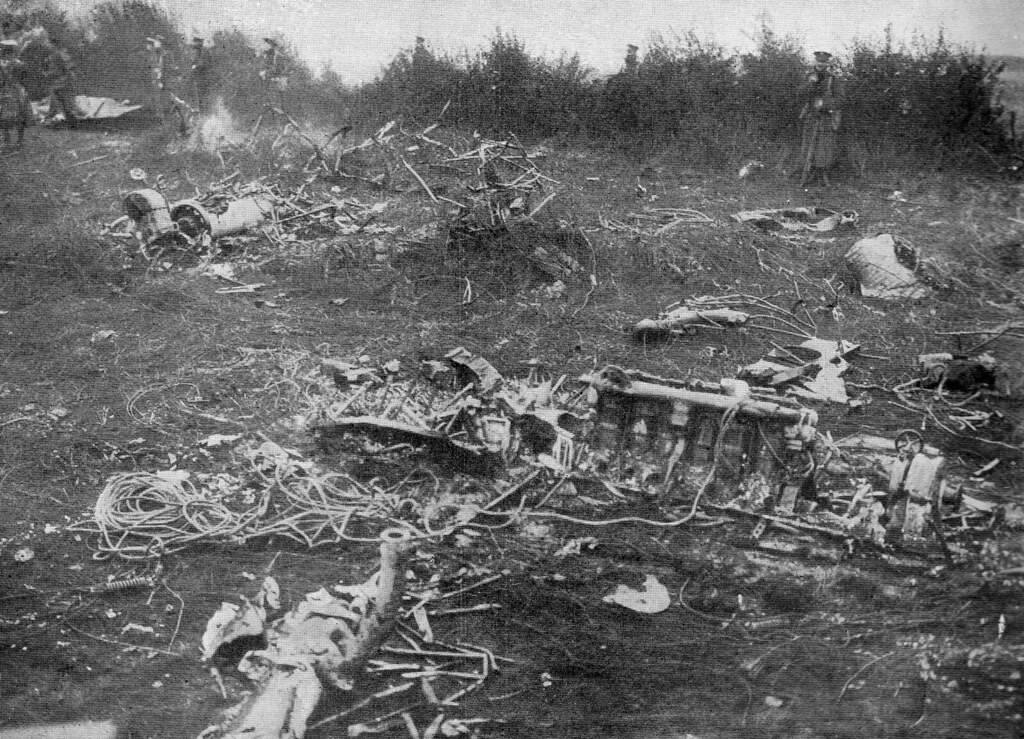 It is the first time that a German airship has been brought down over Britain, and demonstrates the ability of incendiary bullets to ignite an airship's hydrogen gas. Robinson's victory is a sensation, and tens of thousands of Londoners descent on Cuffley after daylight to see the ruins of SL11, including the charred bodies of its crew. When Robinson himself motors over from his airfield to inspect his kill, he is mobbed by well-wishers, and given several 'prizes' from the airship, including an Iron Cross found among the debris and a gold watch believed to have belonged to SL11's captain. For his accomplishment he is also awarded the Victoria Cross. British propaganda postcard entitled "The End of the 'Baby-Killer'"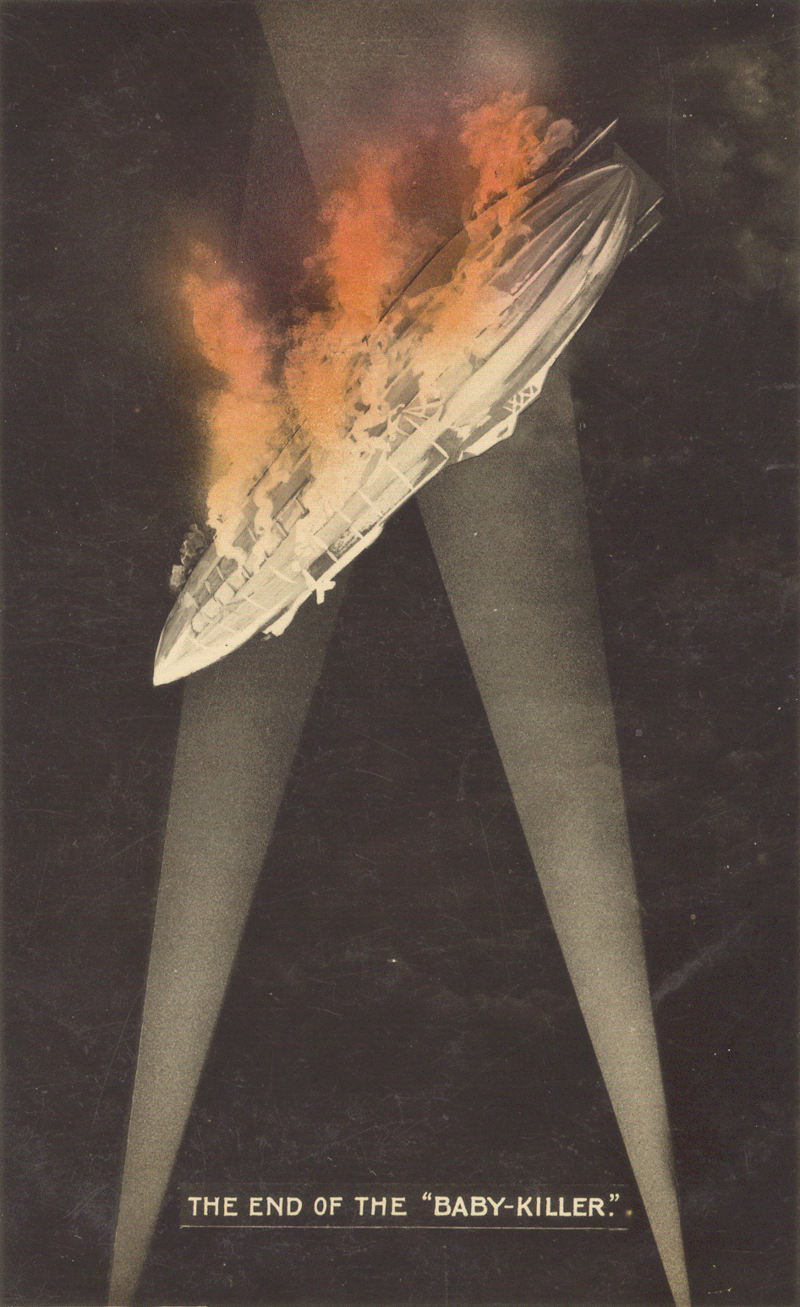 Naval operations: North Sea Naval operations: North SeaBritish freighter SS CHURSTON, 2,470 tons, carrying a load of coal from Cardiff to an unregistered destination, becomes the fourth victim of the minefield laid by UC-7. Franz Wäger's score is now 4,058 tons.
|
|
lordroel
Administrator
Posts: 68,045 
Likes: 49,445
|
Post by lordroel on Sept 4, 2020 5:54:08 GMT
Day 404 of the Great War, September 4th 1915
Western Front: General d'Urbal of 10th Army submits today a plan to Foch
After two revisions, General d'Urbal of 10th Army submits today a plan to Foch that is acceptable to the commander of the Army Group of the North. Along the thirty-two kilometre stretch of the line held by 10th Army will be deployed six corps, four of which are to make the primary attack north of Arras, and two a supporting attack south of the city.
Eastern Front: German 8th Army captures the fortress of Grodno
On the Eastern Front the German 8th Army captures the fortress of Grodno, between Vilna and Bialystok. Further south, Austro-Hungarian forces have been battering against the Russian defensives along the Sereth River to no avail; in just four days of marching and combat, the Austro-Hungarian IV, XIX, and V Corps have suffered eight thousand casualties. Moreover, supply problems bedevil the Austro-Hungarian formations, who report being short of ammunition and food. Finally, dysentery and stomach flu claim numerous victims in the terrible conditions.
Naval operations: Celtic Sea
Walther Schweiger, commanding U-20, torpedoes British passenger liner SS HESPERIAN, 10,920 tons, bound from Liverpool to Montreal with a general cargo plus passengers. The ship survives the attack temporarily, but sinks two days later while under tow, giving Schweiger a score of 18 ships and 87,251 tons.
Konrad Gansser, in U-33, sinks British tanker CYMBELINE, 4,505 tons, heading from Port Arthur to Dartmouth with a load of oil; Freighter MOMOSA, 3,466 tons, carrying oil in drums from New York to Belfast and Liverpool; and Norwegian freighters GLIMT, 955 tons, travelling in ballast from Ellesmere to Gaspé; and sailing ship STORESAND, bound from Iquique to Liverpool with a load of nitrate. His score is now 12 ships and 23,172 tons.
Naval operations: Mediterranean Sea
Claus Rücker, in U-34, has moved from the Atlantic to warmer waters, and starts his third war patrol with the sinking of British freighter SS NATAL TRANSPORT, 4,107 tons, bound from Bombay to Liverpool with a general cargo, off the coast of Crete. His score is now 9 ships and 23,187 tons.
Naval operations: German East Africa
At 0945 hours HMS SEVERN is patrolling off the mouth of the Simba Uranga when a boat is seen crossing the mouth of the river and men landng and entering a hut where they shouldn't be. General Quarters is sounded. SEVERN fires five shrapnel rounds at the hut, then departs.
|
|
lordroel
Administrator
Posts: 68,045 
Likes: 49,445
|
Post by lordroel on Sept 5, 2020 5:52:55 GMT
Day 405 of the Great War, September 5th 1915
Western Front: preparing for their fall offensive in Champagne
For weeks the French army have been preparing for their fall offensive in Champagne, digging both new trenches behind the front to conceal the attacking forces as well as new trenches into No Man's Land to minimize the time the infantry must spend exposed before reaching the German trenches. In addition, substantial additional forces have been assembled behind French lines as well as the massive supplies and munitions necessary for the offensive; indeed, an entirely new rail line has been constructed solely to bring supplies up to the front as efficiently as possible. Given the scale of the preparations, it has naturally been impossible to hide them from the Germans. Aerial reconnaissance has clearly indicated the assembly of French reserves, and in the chalk earth of the region new trenches are visible over large distances. There have even been several French deserters, who have arrived in German lines reporting of an offensive planned for September. In light of these signs, General Karl von Einem, commander of the German 3rd Army opposite the French buildup in Champagne, reports to OHL today that 'it is no longer possible but rather probable that a carefully and long-planned attack is imminent.' Forewarned, the Germans naturally improve their own defensive positions even as the French prepare to attack them.
Naval operations: Black Sea
An Ottoman convoy of three steamers, sailing from the Black Sea port of Zonguldak to the Bosphorus and escorted by the armoured cruiser HAMDIDIEH and two torpedo boats, is intercepted today by the Russian destroyers BUISTRI and PRONZITEINI, and the resulting debacle reemphasizes the hopeless state of the Ottoman navy. Not only do the two destroyers outduel HAMDIDIEH, but the latter's main guns break down and is forced to drop out of the action, after which the Russian destroyers force the three steamers to run aground. Afterwards, German officers with the Ottoman navy concede that the steamers carrying coal on the convoy route to the Bosphorus would be better off without Ottoman 'escorts'.
Though the battle reinforces the superiority of the Russian Black Sea Fleet over the Ottomans, another element is added to the balance when the German submarine UB-7 begins its first patrol in the Black Sea today. The first deployment of a German U boat north of Constantinople, Russian operations will henceforth need to be cognizant of the potential threat from beneath the waves.
Naval operations: South Celtic Sea, off the English Channel
Walther Schwieger, commanding U-20, sinks three more ships - British freighters DICTATOR, 4,116 tons, bound from Pernambuco to Liverpool with a general cargo; DUORO, 1,604 tons, carrying a general cargo from Oporto to Liverpool; and Russian freighter SS RHEA, 1,145 tons, heading from Valencia to Glasgow with a load of fruit. Schwieger's score is now 21 ships and 94,116 tons.
|
|
lordroel
Administrator
Posts: 68,045 
Likes: 49,445
|
Post by lordroel on Sept 6, 2020 6:31:09 GMT
Day 406 of the Great War, September 6th 1915Western Front: Haig does not hold back in explaining why the attack will be undertakenIn writing to Generals Rawlinson (of IV Corps) and Gough (of I Corps) today about their roles in the forthcoming offensive in France, Haig does not hold back in explaining why the attack will be undertaken: they had been 'forced . . . to abandon their defensive attitude' by the 'losses incurred by the Russians.' Not exactly a rousing call to arms. Eastern Front: northern wing of the Austro-Hungarian 2nd Army pushes through the Russian position at Podkamien On the Eastern Front, the northern wing of the Austro-Hungarian 2nd Army pushes through the Russian position at Podkamien, and forces the southern wing of the Russian 8th Army to fall back to the Ikwa River. As this advance is occurring, the Russians undertake their first major counteroffensive to the south today when elements of the Russian XI Corps advance this afternoon out of bridgeheads they had maintained on the west bank of the Sereth River just west of Trombowla. The advance strikes the inner wings of Südarmee (to the north) and the Austro-Hungarian 7th Army at a moment when the attention of their commanders are on attacks about to be launched elsewhere. On the southern wing of Südarmee, the Russians are able to push into the poorly-constructed defences of the Austro-Hungarian 55th Division, and counterattacks by the corps' reserve are unable to restore the situation. Just to the south the Russians are able to break through between the Austro-Hungarian 131st Brigade and 7th Division at Janow. Map: The Russian counteroffensive along the Sereth River, Sept. 6th to 8th, 1915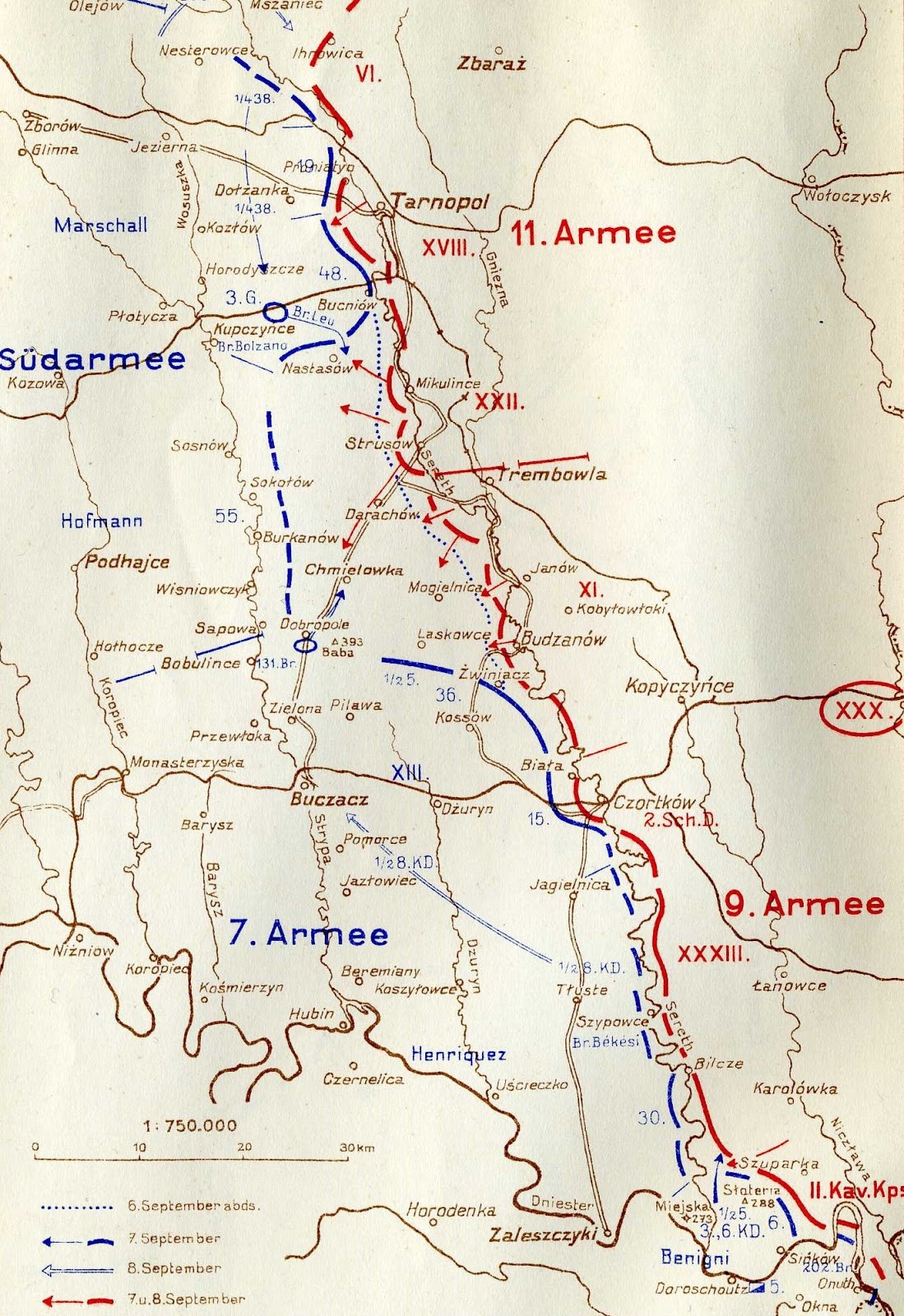 - With the approval of his government, Lieutenant-Colonel Ganchev signs the military convention at Pless by which Germany, Austria-Hungary, and Bulgaria agree to a five-year defensive treaty and the latter pledges to enter the war on the side of the former. For the campaign against Serbia, Germany and Austria-Hungary agree to commit six divisions each to an offensive against Serbia within thirty days, while Bulgaria will join the offensive within thirty-five days with four divisions. In return Bulgaria is promised Macedonia and additional Serbian territory east of the Morava River, and further should either Greece or Romania enter the war on the side of the Entente Bulgaria will be entitled to recover those lands lost in the Second Balkan War. The Germans agree to loan Bulgaria 200 million francs, while the latter agree to permit unimpeded transport of war material through Bulgarian territory to the Ottoman Empire. Finally, on the insistence of the Bulgarian government the convention stipulates that General Mackensen will be in overall command of the invasion of Serbia, a term as pleasing to Falkenhayn as it is upsetting to Conrad. Given the state of the Austro-Hungarian army and its abject failure in 1914 to conquer Serbia despite three separate offensives, it is entirely understandable that the Bulgarians want a German general to command the combined operation. Conrad naturally sees this (quite correctly) as an affront, given Austria-Hungary's view of the Balkans as falling within its sphere of influence, but he is in no position to object. It is also worth noting that on the German side the convention was negotiated and signed entirely by Falkenhayn and his staff - at no point was the civilian government of Germany involved in the decision, reflecting the growing power of the German army to dictate war policy within Germany. Naval operations: Bay of BiscayWalther Schwieger, commanding U-20, has moved south. Southwest of Belle-Île-en-Mer he torpedoes French freighter SS Guatamala, 5,913 tons, bound from St. Nazaire to Philadelphia. His score is now 22 ships and 100,029 tons - the first submarine captain to break the one hundred thousand mark. Naval operations: Atlantic OceanOff the coast of Spain Konrad Gansser, in U-33, ends his third war patrol with the capture of SS JOHN HARDIE, 4,372 tons, carrying a load of sugar from Java to Glasgow, and sinks her with his deck gun. His score is now 13 ships and 27,544 tons.
|
|
lordroel
Administrator
Posts: 68,045 
Likes: 49,445
|
Post by lordroel on Sept 7, 2020 6:23:23 GMT
Day 407 of the Great War, September 7th 1915
Eastern Front: Russians build on their successful counterattack west of Trembowla
Overnight the Russians build on their successful counterattack west of Trembowla, as parts of the Russian XXII Corps, passing through the lines seized yesterday from the Austro-Hungarian 55th Division to fall on the flank of a brigade commanded by Colonel Edler von Bolzano at dawn. Caught preparing to attack, the Austro-Hungarian 81st and 88th Regiments are routed and flee through Nastasow, leaving numerous prisoners in the hands of the Russians. Both 55th Division and 131st Brigade on its right flank are forced back almost to the Strypa River. The Russian XI Corps further expands the breakthrough this evening by forcing back the Austro-Hungarian 36th Division on the southern shoulder of the advance.
Balkan campaign: orders begin to go out for the deployment of the forces that will participate in the operation
With the signing yesterday of the convention between Germany, Austria-Hungary, and Bulgaria regarding the invasion of Serbia, orders begin to go out for the deployment of the forces that will participate in the operation. On the German side, besides 101st Division which is already in the Balkans, 11th Bavarian and 105th Division, as well as X Corps are to come from the Eastern Front. As for the Austro-Hungarians, two corps - VI and XVII - are to come from the Eastern Front while two divisions - 57th and 59th - are to be redeployed from the Italian Front.
Naval operations: North Sea
Werner Fürbringer, in UB-2, scuttles fishing smacks CONSTANCE, 57 tons, and EMMANUEL, 44 tons, bringing his score to 9 vessels and 655 tons.
Hans Valentiner, in UB-16, scuttles fishing smacks EMBLEM, 50 tons, and VICTORIOUS, 43 tons. His score is now 9 ships and 9,853 tons.
Naval operations: Bay of Biscay
Walther Schwieger, commanding U-20, attacks French freighter SS BORDEAUX, 4,604 tons, carrying 4,200 tons of barley from Saffi to Bordeaux, with his deck gun, then sinks her with a torpedo. Also sunk is British freighter SS CARONI, 2,652 tons, bound from London to Bordeaux with a cargo of stores. Schwieger's score is now 24 ships and 107,287 tons.
|
|
lordroel
Administrator
Posts: 68,045 
Likes: 49,445
|
Post by lordroel on Sept 8, 2020 5:32:47 GMT
Day 408 of the Great War, September 8th 1915
Western Front: British 1st Army continues planning for the attack scheduled for later this month
- As the British 1st Army continues planning for the attack scheduled for later this month to coincide with the great French fall offensive, the command staff of the corps and divisions work long hours to prepare the necessary orders and instructions. As the BEF rapidly expands, officers find themselves in positions far above their prior experience, and not all prove up to the task: today Major General H. J. S. Landon breaks down and has to be invalided back to Britain sick, and is replaced as commander of 9th Division by Major General G. H. Thesiger.
- Despite Joffre's opposition, he has been ordered by the minister of war to identify four divisions for deployment to the Near East, forcing the French commander-in-chief to shift to stalling; he writes today that ongoing preparations for the fall offensive in Champagne and Artois prevent him from pinpointing the required divisions.
Eastern Front: Austro-Hungarian X and XIV Corps launch furious attacks against the Russian XXXIX Corps
- After several days of preparation, the Austro-Hungarian X and XIV Corps launch furious attacks against the Russian XXXIX Corps along the Putilowka River covering Rovno. Fog, however, reduces the effectiveness of the preliminary bombardment, and heavy rain has turned the low ground along the river into a swamp. Thus when the Austro-Hungarian infantry advances, they find themselves bogged down in mud and under intense Russian defensive fire, and the attack soon collapses. Conrad had expected this attack to be the decisive moment of the offensive, which would lead to the much-desired envelopment of the Russian 8th Army from the north. On its failure, Conrad vents his anger at the commander of 4th Army, noting that he has a superiority of almost 3-to-1 on the northern end of the front and that the rest of the line had been thinned to provide this advantage.
East Africa Protectorate: Kenyan Governor Sir Charles Belfield forms a War Council to direct the colony's war effort
After receiving instructions from London to fully cooperate with the military, Kenyan Governor Sir Charles Belfield formed a War Council to direct the colony's war effort. Its membership consists of four civil officials, two military representatives, and six representatives of the settler community. The latter thus hold the balance of power on the council, and use their position not only to aid the army but also protect their own interests. Their priorities are reflected in the Native Followers Recruitment Ordinance, which is proclaimed today. To operate in the interior of Africa requires vast numbers of porters to carry all of the required supplies and food, and the ordinance provides for the enlistment of three thousand Africans per month into the Carrier Corps. In addition, it lowers the pay of porters from the ten to fifteen rupees per month now prevalent to five to six, and exempts Africans working on the farms of European settlers. The ordinance ensures not only the adequate provision of porters for the army, but also that manpower on European farms will remain plentiful: lower pay for porters ensures that Africans already employed on plantations will not be tempted to join the Carrier Corps for higher pay, while Africans who wish to avoid the Carrier Corps can do so by working on European-owned land. The settler community in Kenya has thus used the pretext of military requirements to ensure the continued supply of cheap African labour for their farms.
Aerial operations: German army Zeppelins LZ74 and SL2 undertake a bombing raid on London
Overnight the German army Zeppelins LZ74 and SL2 undertake a bombing raid on London. The latter drops its bombload over the docks east of the City, while the former manages to reach the City itself, and though it has only a single incendiary left, LZ74 becomes the first German Zeppelin to strike the heart of London.
Naval operations: North Sea
British cable ship MONARCH is sunk by a mine laid by Herbert Pustkuchen and UC-5. Pustkuchen's score is now 7 ships and 8,942 tons.
Naval operations: Bay of Biscay
Walther Schwieger, commanding U-20, sinks British freighter SS MORA, 3,047 tons, en route from Santander to Newport with a load of ore. Schwieger ends his fifth war patrol with 25 ships and 110,334 tons.
Naval operations: Aegean Sea
Claus Rücker, in U-34, ends his third war patrol with the sinking of French auxiliary patrol boat INDIEN, 800 tons, riding at anchor outside the harbor at Rhodes. His score is now 10 ships and 23,987 tons.
|
|
lordroel
Administrator
Posts: 68,045 
Likes: 49,445
|
Post by lordroel on Sept 9, 2020 5:57:22 GMT
Day 409 of the Great War, September 9th 1915Eastern Front: Ludendorff launches his offensive today, consisting of an attack against Vilna itself and an attempt to outflank the city from the north- Having concentrated twenty-eight infantry and five cavalry divisions along the 110 kilometres of the front opposite Vilna held by General Max Eichorn's 10th Army, Ludendorff launches his offensive today, consisting of an attack against Vilna itself and an attempt to outflank the city from the north. The former runs into strong Russian defensive positions and gets nowhere, but the latter, undertaken by three infantry and three cavalry divisions, is far more successful, as the Russian line is weakest north of Vilna. The Russian 10th Army, formerly responsible for the defence of Grodno, has been drawn into the fighting at and south of Vilna. Its northern neighbour - 5th Army - has been focused on holding Riga and the lower Dvina River, leaving its southern flank weakened. The German attack north of Vilna is directed right into the gap between the two Russian armies, which is only covered by a scratch force of six hundred Latvian cavalry under the oldest cavalry commander in the Russian army (considering the average age of a Russian general, this is no small accomplishment). This force is scattered, and the Germans push forward. The initial reaction on the Russian side is that the frontal attack on Vilna is the main German advance, and that the action to the north is of no great importance: reports of the German force as dismissed as exaggerations and that any German success here is only the result of incompetence by officers on the ground - true enough, but it is a significant underestimation of the threat of the German advance. Map: The advance of the German 10th Army against Vilna, in what will become known as the Sventsiany Offensive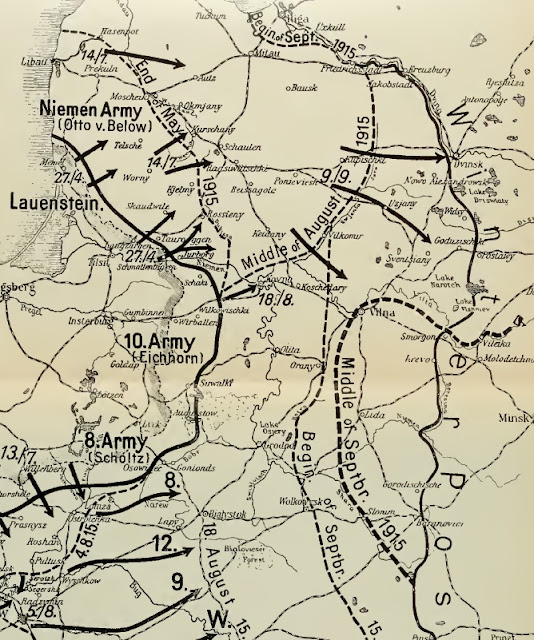 - Though the northern wing of the Russian 8th Army repulsed the Austro-Hungarian attack along the Putilowka River yesterday, its southern wing had been pulled back in response to the enemy advance at Podkamien on the 6th. As a result, to maintain a cohesive defensive line the northern wing pulls back from the Putilowka a short distance to the Stubien, the next river on the way to Rovno. To the south, the Russian withdrawal allows the Austro-Hungarians to occupy Dubno today as they pull up to the new Russian line along the Ilka River. The Russian 8th Army, however, remains intact and capable of offering stiff resistance to further Austro-Hungarian advances. Map: The withdrawal of the Russian 8th Army to the Subiel River, Sept. 9th, 1915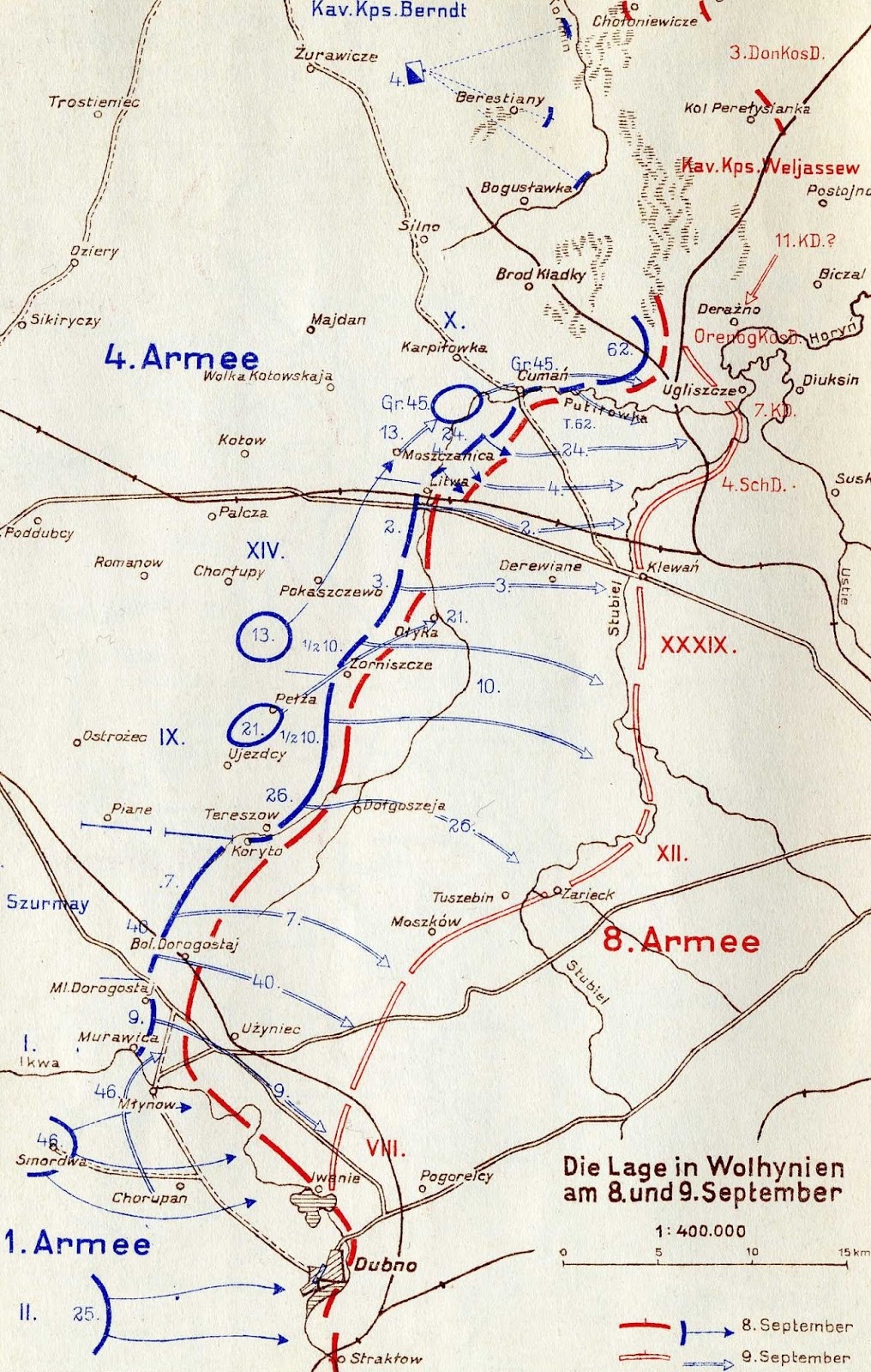 To the south, where it is the Russians who are now attacking, the same cannot be said for the Austro-Hungarians. The latter's 2nd Army attempts a counterattack north of the breakthrough in the direction of Zbaraz north of Tarnopol, in an attempt to turn the flank of the advancing Russians. Poor weather, however, hindered the Austro-Hungarian attack, and it is repulsed. Instead, the Russians continue to advance, with XI Corps of 9th Army advancing southwest from the line Laskowce-Ziniacz on the southern face of the breakthrough. The Austro-Hungarian 36th and 15th Divisions of XIII Corps are forced back through Kossow this morning, and by noon have lost touch with 131st Brigade to the northwest. After further attacks this afternoon the battered XIII Corps, which has lost 17 000 men (more than half its strength) already this month, is ordered by the commander of 7th Army to fall back further, to Buczacz on the Strypa River and the line Joazlowiec-Koszylowce to the southeast, which expands the length of the Russian breakthrough. Map: The expansion of the Russian breakthrough at Trembowla, Sept. 9th to 12th, 1915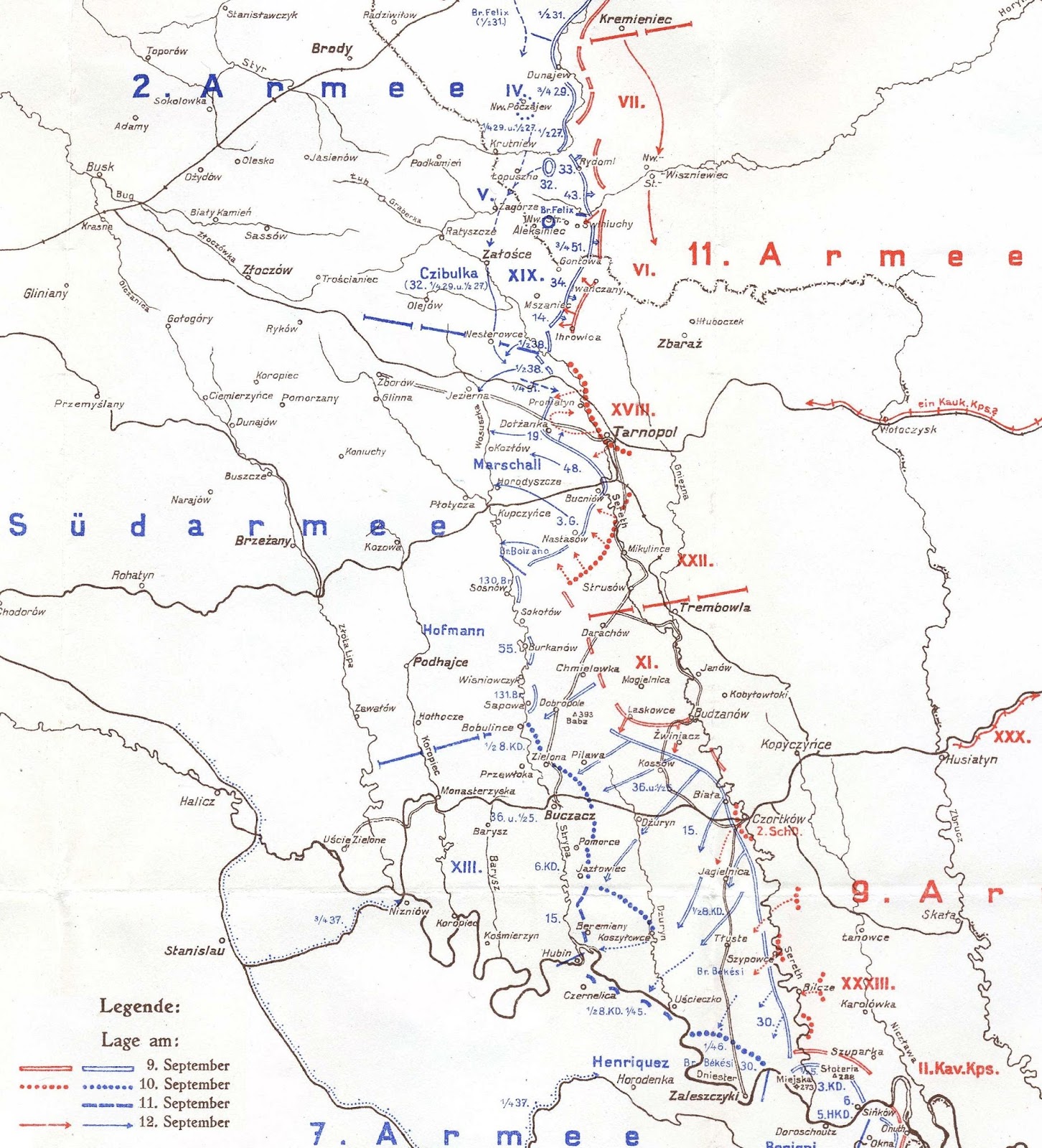 Aerial operations: German Navy sends 4 Zeppelins to raid Britian Aerial operations: German Navy sends 4 Zeppelins to raid BritianAfter the success of the German army Zeppelins in attacking London on the night of September 7th-8th, the German navy sends four of its Zeppelins against Britain overnight. L11 and L14 are forced to turn back due to engine trouble, while L9 narrowly misses the benzol works at Skinningrove on the Yorkshire coast. L13 makes landfall on the Norfolk coast, and by the time it approaches Cambridge the lights of London are already visible on the horizon, guiding the Zeppelin to its target. The captain of L13 remains patient as his Zeppelin crosses over London, and waits until it reaches the heart of the British capital where it does considerable damage - most notably, several bombs strikes the textile warehouses north of St. Paul's Cathedral, leaving Wood Street, Silver Street, Addle Street, and Aldermanbury ablaze and destroying many valuable buildings. Four bombs are also dropped on Liverpool Street Station, and though only a few feet of track are destroyed, two of them score direct hits on nearby motor-buses, which raises the night's deathtoll to twenty-two. It is a great success for L13, and indeed, by monetary loss, it will be the single most destructive raid of the war against the British capital. Photo: Bomb damage outside Liverpool Street Station in London, Sept. 9th, 1915 Naval operations: North Sea Naval operations: North SeaBritish tanker SS BALAKANI, 3,696 tons, hauling oil from Port Arthur to London, is sunk by a mine laid by Egon von Werner in UC-1. Werner's score is now 6 ships and 7,331 tons. Naval operations: Mediterranean SeaWalter Forstmann, in U-39, sinks British freighter SS CORNUBIA, 1,736 tons, carrying a cargo of beans from Alexandria to Clyde; and French freighters L'AUDE, 2,232 tons, captured and sunk with the deck gun while travelling in ballast from Maseill to Oran; and VILLE DE MOSTAGANEM, also travelling from Marseille to Oran with a load of empty barrels. His score is now 25 ships and 45,126 tons.
|
|
lordroel
Administrator
Posts: 68,045 
Likes: 49,445
|
Post by lordroel on Sept 10, 2020 5:41:28 GMT
Day 410 of the Great War, September 10th 1915
YouTube (The Socialists Call for Peace - But the Plans Do Not)
Eastern Front: The corps of the Austro-Hungarian 4th and 1st Armies are ordered by Conrad to make 'an immediate, decisive attack' on the northern wing of the Russian 8th Army
- The corps of the Austro-Hungarian 4th and 1st Armies are ordered by Conrad to make 'an immediate, decisive attack' on the northern wing of the Russian 8th Army, in yet another attempt to turn the Russian flank and envelop the enemy line. Given the deteriorating situation to the south, a successful assault here is imperative if the offensive is to be successful. Conrad's demands, however, overlook the battered and exhausted state of 4th and 1st Army, both having suffered heavy losses in near-constant combat over the past two weeks. Supplies have been drawn by horse-cart over poor roads from rail-heads that are two hundred kilometres to the west, and even food is running short.
To the south, the situation worsens for the Austro-Hungarian 7th Army. After XIII Corps on its northern wing was forced back yesterday, the Russian 9th Army strikes at a scratch corps commanded by General Johann Henriquez, forcing its 15th Division back to the confluence of the Strypa and Dniester Rivers. The Russians now threaten to drive over the Dniester between XIII Corps and Henriquez's command, with only half a cavalry division covering the growing gap between them.
- As part of the military convention with Bulgaria, Austria-Hungary had pledged to dispatch six divisions from the Eastern Front for operations against Serbia, the same number promised by Germany. The rapidly deteriorating situation of the Austro-Hungarian armies participating in Conrad's ill-fated offensive makes it uncertain whether the Austro-Hungarian chief of staff can afford to pull six divisions out of the fight to transfer to the Balkans. Falkenhayn recognizes the difficulty of his ally, and writes to Conrad today to offer German divisions to take the place of the Austro-Hungarians. He cannot resist, however, commenting on the apparent necessity of the German army once again bailing out their ally after the latter botches yet another operation: 'Certainly such a change in plans won't make up for the political and military damage already inflicted. However, it may avert even more unfavourable results, which to me seems all the more important because of the affect on the morale of the Russian army and on Romania.' Conrad thus decides that VI Corps, which had been about to board trains for the Serbian front, will instead be dispatched to reinforce the faltering 7th Army.
Naval operations: Italian navy
There is growing unease regarding the performance, or more accurately the lack thereof, of the Italian navy to date in the war. Expecting dramatic victories over the Austro-Hungarian foe, instead the first months have been marked by hesitancy and embarrassment. Today a leading article appears in the newspaper Giornale d'Italia penned by Enrico Arlotta, a Deputy in the Italian parliament. Sharply critical of the navy, it questions the adequacy of pre-war preparations and questions whether those responsible for the navy have all the 'desirable mental agility'. Given not only that the article was allowed to be published by government censors, but that it appeared in a newspaper associated with Prime Minister Salandra and Foreign Minister Sonnino, it suggests that dissatisfaction with the conduct of the war at sea has reached the highest political circles.
Naval operations: North Sea
Reinhold Lepsius, commanding U-6, sinks Norwegian sailing vessel PRESTO, 206 tons, bound from Moss to Tyne with a load of pit props. His score is now 15 ships and 9,866 tons.
Werner Fürbringer, in UB-2, sinks fishing smack BOY ERNIE, 57 tons. He ends his third war patrol with 10 fishing vessels and 702 tons.
Hans Valentiner, in UB-16, ends his third war patrol with the sinking of fishing smack NIMROD, 51 tons. He now has 10 vessels and 9,904 tons.
|
|
lordroel
Administrator
Posts: 68,045 
Likes: 49,445
|
Post by lordroel on Sept 11, 2020 6:39:17 GMT
Day 411 of the Great War, September 11th 1915
Eastern Front: elements of the German Guard Corps begin entraining for the journey to Belgium
- Having arrived at Warsaw after a two-week march from Brest-Litovsk, elements of the German Guard Corps begin entraining for the journey to Belgium.
- North of Vilna German cavalry, pushing into the gap between the Russian 10th and 5th Armies, approaches the town of Sventsiany today.
- While V and XIX Corps of the Austro-Hungarian 2nd Army have spent several days in fruitless and costly assaults on Russian positions west of Zbaraz, to the south the Russians continue to expand their breakthrough at Trembowla, this morning driving through Dolzanka and forcing the Austro-Hungarian 19th Division to fall back in disorder. The latter drive threatens to turn the southern flank of 2nd Army, and its commander orders V and XIX Corps to go over to the defensive to give time for the exhausted infantry to recover and to allow for the redeployment of forces southward to stem the tide of the Russian advance.
mesopotamian campaign: General Townshend orders a further advance to Sannaiyat
Having concentrated his forces at Ali-al-Gharbi on the Tigris river, General Townshend orders a further advance to Sannaiyat, downriver from Kut-al-Amara.
Naval operations: North Sea
Reinhold Lepsius, commanding U-6, sinks Norwegean bark SV WANSBECK, 462 tons, bound from Porsgrund to Leith with a cargo of pit props; and capturs freighter SS RANDULF HANSEN, 1,287 tons, carrying pit props from Fredrikstad to London, as a a prize. His score is now 17 ships and 11,615 tons.
|
|
lordroel
Administrator
Posts: 68,045 
Likes: 49,445
|
Post by lordroel on Sept 12, 2020 6:09:42 GMT
Day 412 of the Great War, September 12th 1915Western Front: gunners in Artois begin firing what are known as ranging shots- To prepare for the artillery bombardment that is to precede the French fall offensive, gunners in Artois have been firing what are known as ranging shots, firing single rounds and observing where they land, afterwards adjusting their aim to ensure that when the bombardment begins, their shells land precisely on target. Such ranging of the artillery is standard practice before major operations, but the landing of single enemy shells also serves as an unmistakable sign that a major artillery bombardment is imminent. Thus today the German VI and I Bavarian Reserve Corps, which cover the front at Arras and Vimy Ridge, report to 6th Army headquarters that the French have been firing ranging shots on them, signalling an enemy attack is likely imminent. As a response, 6th Army headquarters orders elements of a Saxon brigade in reserve to reinforce the left flank of 5th Bavarian Reserve Division, deemed the weakest point on the army's front. Eastern Front: infantry from multiple divisions advances against Russian positions along the Stubiel River and south towards Dubno- Despite Conrad's orders of the 10th for an immediate attack by 4th and 1st Armies, the exhaustion of their infantry prevented the advance occurring until today, when infantry from multiple divisions advances against Russian positions along the Stubiel River and south towards Dubno. The advancing infantry encounter heavy artillery fire, however, and suffer greatly, and by this evening the attacks have clearly failed to gain any significant advantage. Today's defeat dashes the last hopes for Conrad's grand offensive - both Südarmee and 7th Army are in full retreat, which has already forced 2nd Army onto the defensive, and it was clear that only prolonged operations at great cost could accomplish anything of note on the northern end of the line. Moreover, intelligence has reached Conrad that the Russian XXX Corps will arrive within the next couple of days to reinforce 8th Army, rendering the prospects of success even more unlikely. With utmost reluctance, Conrad signals his army commanders to abandon the offensive, with both 4th and 1st Armies sending reinforcements southwards. Unfortunately for Conrad, the Russians, having gained the upper hand, have every intention of pressing their advantage to the fullest. At the southern end of the line, the Russian XXXIII Corps attacks the scratch Austro-Hungarian corps under General Henriquez. Having lost seven thousand infantry already in September, Henriquez's corps collapses under the weight of the Russian advance, and falls back in disorder to the Dniester River. Map: The Russian advance vs. Südarmee and the Austro-Hungarian 2nd Army, Sept. 12th to 15th, 1915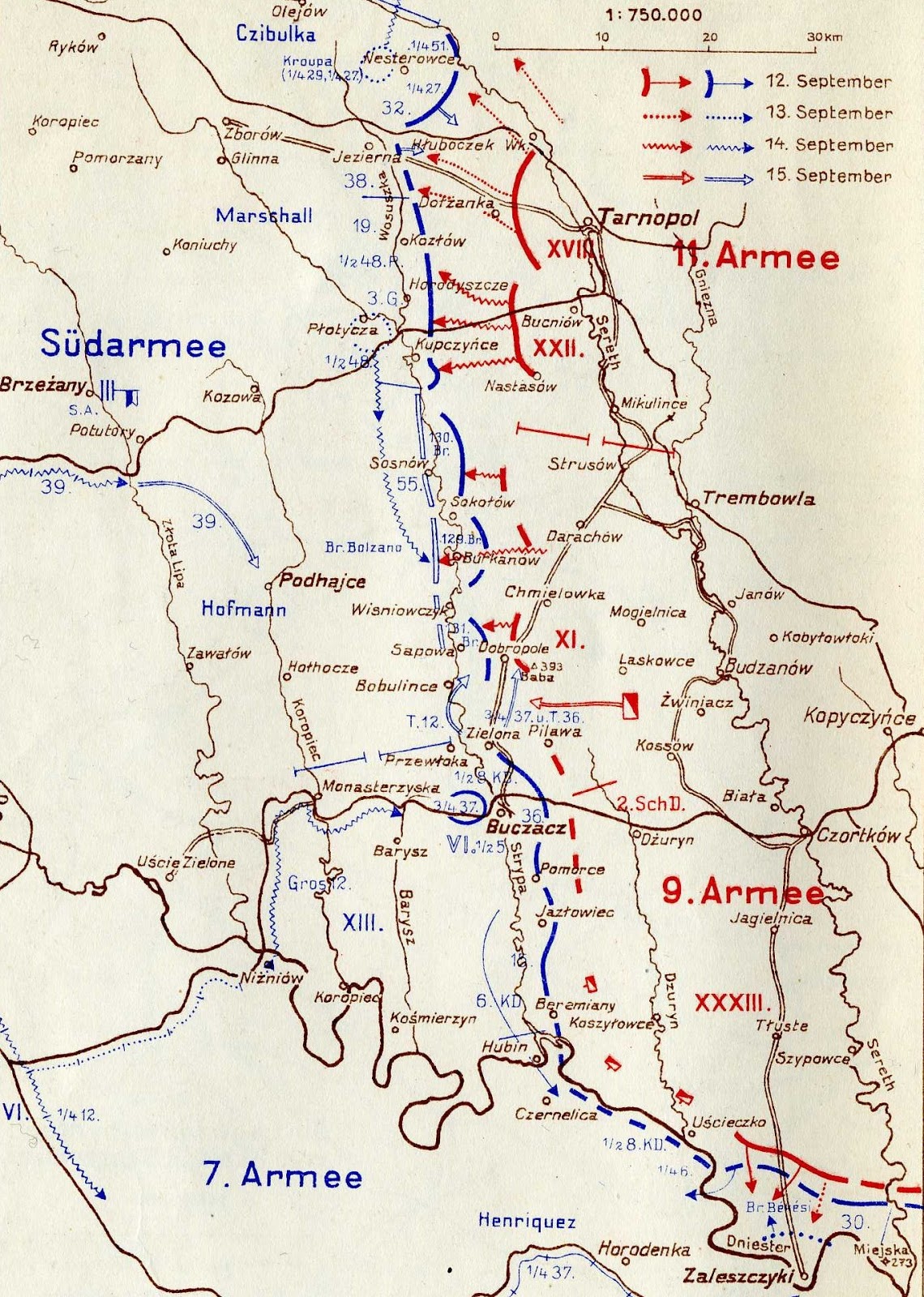 Further, after several weeks of falling back before the Austro-Hungarian advance, General Brusilov of 8th Army intends to go over to the counterattack, which will begin tomorrow with a thrust by XXXIX Corps across the Stubiel River at Klewan northwest of Rovno. Meanwhile, XXX Corps, detraining at Rovno today, is to march north behind the front and descend on the north wing of the Austro-Hungarian 4th Army. Brusilov's objective is to turn the enemy flank and recover Lutsk. Aerial operations: Falkenhayn cautions the navy to avoid hitting residential areas in London and other citiesAs naval Zeppelins continue their bombing campaign of British targets, Falkenhayn cautions the navy to avoid hitting residential areas in London and other cities, lest the British and French launched reprisal raids on German cities. Naval operations: North SeaReinhold Lepsius, commanding U-6, sinks Norwegean motor vessel MV BIEN, 120 tons, bound from Arendal to Methill with a cargo of pit props. His score is now 18 ships and 11,735 tons. Bien was a three-masted sailing ship with a motor installed in 1910. Photo: SMS U-6 before the war British freighter SS ASHMORE, 2,519 tons, carrying a load of maize from Rosario to Rotterdam, is sunk by a mine laid by Erwin Weisbach and UC-3. Weisbach's score is now 5 ships and 4,170 tons.
|
|
lordroel
Administrator
Posts: 68,045 
Likes: 49,445
|
Post by lordroel on Sept 13, 2020 5:44:58 GMT
Day 413 of the Great War, September 13th 1915
Eastern Front: German cavalry capture the town of Sventsiany
- German cavalry capture the town of Sventsiany today, severing the railway linking Riga and Vilna. With little opposition as yet, the cavalry shifts to the southeast, advancing towards Smorgon and Molodechno on the railway running east from Vilna.
- The counteroffensive of the Russian 8th Army opens today when the left wing of XXXIX Corps attacks across the Stubiel River on both sides of the village of Klewan. In the thick morning fog, Russian forces are able to punch through the thin lines held by the inner wings of the Austro-Hungarian X and XIV Corps. The advance draws in the reserves of the Austro-Hungarian 4th Army - 21st Landwehr and 2nd Divisions - which are able to contain the Russian breakthrough. To the south, elements of the Russian VII Corps of 11th Army break through the left wing of the Austro-Hungarian 43rd Landwehr Division; in the confusion that follows, the Austro-Hungarian 26th Regiment is cut off and overwhelmed by Russian forces, and the remainder of V Corps is falls back almost ten kilometres.
Naval operations: North Sea
Reinhold Lepsius, commanding U-6, sinks Norwegean motor vessel MV NORTE, 216 tons, bound from Drammen to London with a cargo of staves. His score is now 19 ships and 11,951 6ons.
|
|













